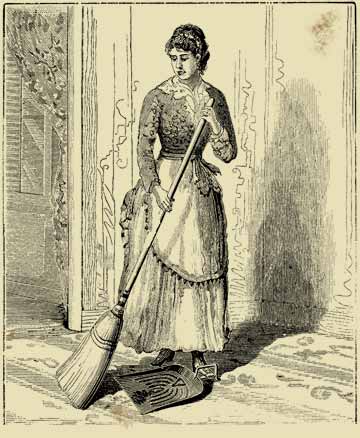At Home In 1879.
The 1879 city directory lists Narcisse as a shoemaker on Van Die, in Bay View, indicating his residence was the same address. This implies he had his own business rather than working in one of the large factories. As to Edesse, available records state only that she kept house. With five boys and two girls ranging in ages 19 years apart there was plenty of work to do around the home. As a working class family, it is possible Edesse and her daughters also took in laundry or sewed clothes to supplement the family income.
Chores.
The first order of business in the morning was to light a wood fire to heat the cast iron stove. Water was brought to a boil in a large iron pot setting on the stove top. Electricity had been invented, but was not available to most, whose homes were lit with oil lamps. It was expensive to heat an entire house, so the working classes would gather around the warmth of the stove in the kitchen on cold nights.

A day was set aside for each home keeping task, hence the origin of the nursery rhyme that recites "This is the way we wash our clothes, So early Monday morning …". This would be accomplished by soaking the soiled laundry in hot soapy water, then scrubbing it vigorously on a washboard. Clothes were hung on lines to air dry - in the kitchen if it was too cold or wet outside. A sad iron [flat iron] was also heated on the stove top and when hot enough would be used to press the wrinkles out of the fabric. Sewing was an important skill; no doubt the boys' clothing needed constant mending as it was passed down to the next youngest. So as not to waste anything, beautiful quilts were made from scraps of fabric leftover from making clothes.
Meals.
Their long backyard was a likely spot for a little vegetable garden to provide carrots, onions and colorful flowers for the home, all watered from the little stream that ran alongside their land.
Bread was a staple in Victorian households and a day was set aside for baking. A typical meal was one of bread or potato – meat and eggs could only be afforded about once a week. When meat was on the menu, it would most often be boiled in a pot with vegetables to stretch the small portion. French families preferred coffee to drink. As in Québec, a tourtiere, may be served, and pea soup was a favorite dish. Eggs poached in maple syrup were cooked for special occasions. Dessert may feature Galette cookies cooked in a hand-held iron, or a pudding of dried pumpkin stewed in syrup, served with a topping of maple syrup and whipped cream.
Attire.
Gentlemen wore a coat, hat and waist coat (vest) but working men tended to go about in shirt sleeves. Their clothes were of wool or cotton. Buttons of stamped brass or cut steel were used to fasten the fly on pants, close shirts and attach suspenders. Fashionable women in Milwaukee were wearing the bustle in 1876. Tightly laced corsets with ribs of steel, whalebone or wood kept the ladies in shape. Hats and gloves were worn when out in public.
- 1879 The Milwaukee Directory, Wm Hogg, publisher; Van Die in directory, Van Dyke, later named Russell
- Old World Wisconsin: Around Europe in the Badger State, by Fred L. Holmes; E.M. Hale and Company, Eau Claire, Wisconsin; 1944
- image from www.karenswhimsey.com at Public Domain Images
